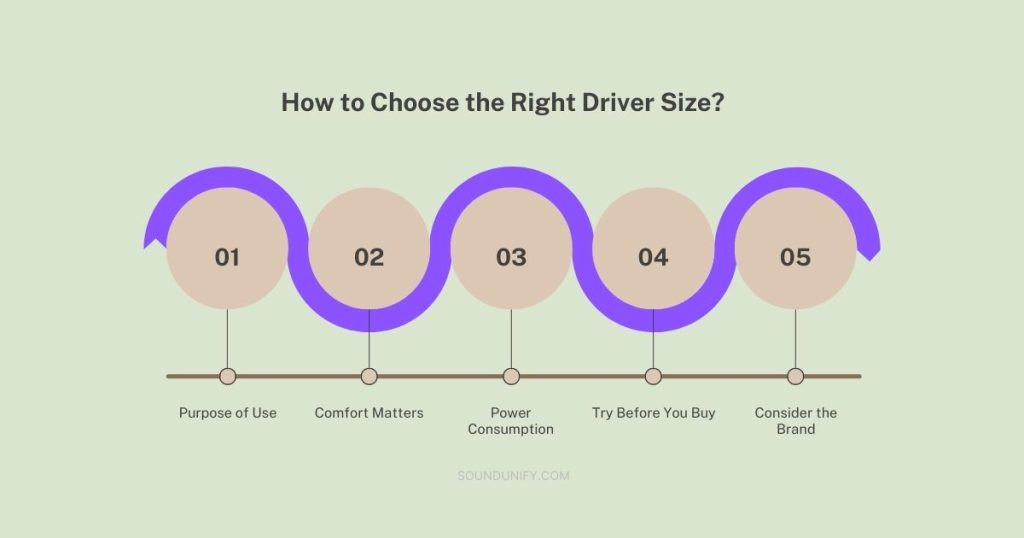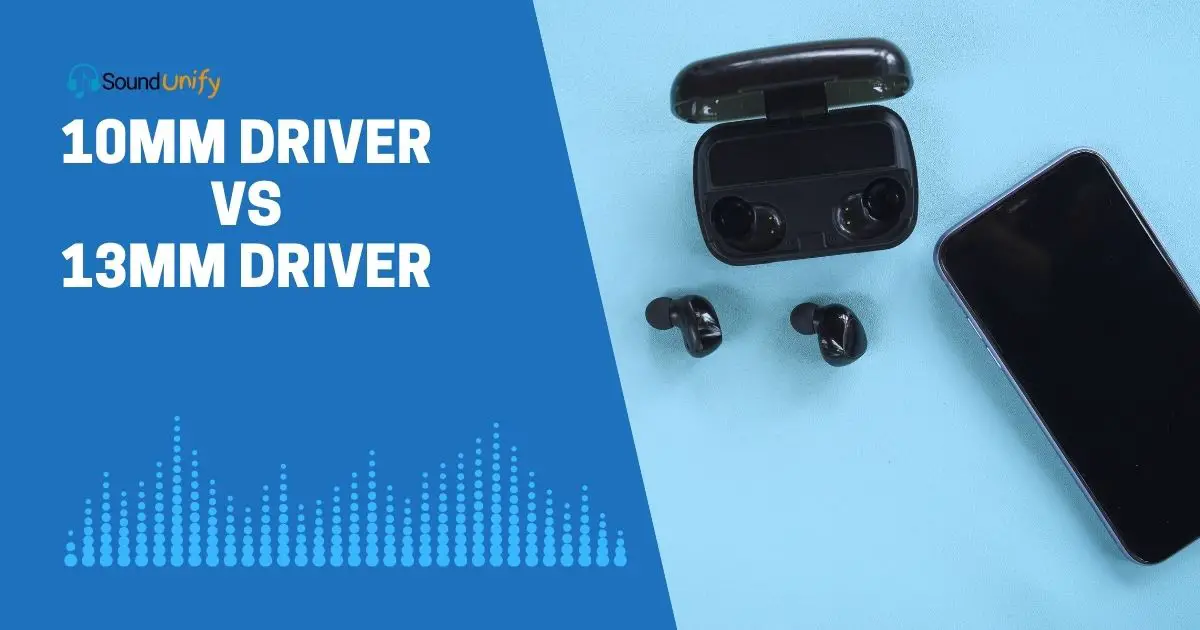A 10mm driver may sound perfect, but have you ever wondered if a 13mm driver could take your audio experience to another level? The answer is it can.
Have you ever wondered about the tiny drivers nestled inside your earbuds? Well, it’s time to shed light on these unsung heroes of your audio experience.
It’s a small component with a big job, and the difference in size, believe it or not, can be a real game-changer.
But here’s the twist: bigger isn’t always the ultimate winner. As with many things, it’s about finding the perfect balance. Choosing between a 10mm driver vs 13mm driver isn’t straightforward and depends on several factors.
This post delves into the nitty-gritty of these two sizes, their strengths and weaknesses, and how to choose the right one for your earbuds.
Ready to become an earbud connoisseur? Let’s dive deeper into the world of drivers.
10mm Driver vs 13mm Driver: My Detailed Comparison
As an audio enthusiast, I often compare the subtle differences between earbud drivers. Today, I want to share my insights about the 10mm and 13mm drivers, hoping to help you find the perfect pair of earbuds.
1. Size and Sound Quality

Size matters in earbud drivers, but it’s not as straightforward as you might think.
When I use earbuds with a 13mm driver, I notice they tend to produce more volume. This is because they move more air, resulting in better bass response. You might prefer these if you’re like me and enjoy bass-heavy music.
However, I’ve also found that they can sometimes struggle with higher frequencies, affecting the clarity of the sound.
Conversely, switching to earbuds with a 10mm driver offers more precise sound reproduction, especially at higher frequencies.
This results in a more transparent, detailed sound, which I enjoy when listening to classical or jazz music.
| Driver Size | Pros | Cons |
|---|---|---|
| 10mm | More precise sound at higher frequencies | It might lack bass |
| 13mm | Better bass response and volume | Can struggle with higher frequencies |
2. Energy Efficiency

In my experience, smaller drivers like the 10mm ones are more energy-efficient.
They don’t require as much power to move the diaphragm, which can be particularly beneficial if you use wireless earbuds like I often do. This efficiency can help extend the battery life of your device.
On the other hand, larger drivers, like the 13mm ones, might consume more power, especially at higher volumes.
But don’t worry. In my experience, the difference in power consumption between these two sizes is typically minimal and might not significantly impact your device’s battery life.
3. Comfort and Fit

Let’s talk about comfort, a critical factor in your listening experience. I’ve found that larger drivers can make earbuds bulkier, which may not fit as comfortably in smaller ears.
On the other hand, earbuds with 10mm drivers are usually more compact and might offer a better fit for a wider range of ear sizes, like mine.
4. Versatility
Regarding versatility, I’ve found that the 13mm drivers cater to a wider variety of audio content due to their more excellent bass response.
Whether I’m watching a movie with a lot of action or listening to bass-heavy music, these drivers deliver.
10mm drivers, on the other hand, shine when it comes to vocal performances, podcasts, or any content that requires precise and detailed sound reproduction.
5. Durability

Regarding durability, I haven’t noticed a significant difference between 10mm and 13mm drivers. Both sizes seem to hold up well over time, provided you take good care of your earbuds.
6. Frequency Response

Regarding frequency response, which is the range of bass, mids, and treble, the 13mm drivers have impressed me with their ability to handle lower frequencies.
They generate strong bass that resonates, which I appreciate when listening to music genres like hip-hop or techno.
However, 10mm drivers take the lead regarding higher frequencies. They offer a more balanced sound across different frequencies, which I’ve found particularly beneficial when listening to acoustic or vocal-centric genres.
7. Soundstage and Imaging

Soundstage and imaging refer to the perceived spatial aspects of sound, and it’s another area where I’ve noticed differences between the two driver sizes.
With 13mm drivers, I’ve found the soundstage to be wider, which gives me the feeling of a live concert. It’s immersive and makes me feel like I’m in the audience.
On the other hand, the 10mm drivers, in my experience, offer better imaging. This means they provide a more precise sense of where each instrument or sound source is located within the soundstage.
I enjoy a more intimate listening experience when listening to classical music or acoustic performances.
8. Compatibility with Devices

Both 10mm and 13mm drivers, in my experience, have shown broad compatibility with a range of devices, from smartphones and tablets to laptops and professional audio equipment.
However, remember that for the best audio experience, your device’s audio output capability should match the capabilities of your earbuds.
Here’s a comparison table summarizing the points discussed:
| 10mm Drivers | 13mm Drivers | |
|---|---|---|
| Size and Sound Quality | More precise at higher frequencies, might lack strong bass | Better volume and bass response may struggle with high frequencies |
| Energy Efficiency | More energy-efficient, less power required | It might consume more power, especially at higher volumes |
| Comfort and Fit | More compact and potentially more comfortable for smaller ears | Bulkier due to larger size, may not fit as comfortably in smaller ears |
| Versatility | Ideal for vocal performances, podcasts, or content requiring precise sound reproduction | Cater to a wider variety of audio content due to more excellent bass response. |
| Durability | Good, provided you take care of your earbuds | Good, provided you take care of your earbuds |
| Frequency Response | A wider soundstage gives the feeling of a live concert | Better at handling lower frequencies, generating strong bass |
| Soundstage and Imaging | Better imaging means a more precise sense of where each sound source is located. | A wider soundstage gives a feeling of a live concert |
| Compatibility with Devices | Broad compatibility with a range of devices | Broad compatibility with a range of devices |
Remember, the choice between 10mm and 13mm drivers should be based on your preferences and how you intend to use your earbuds.
So, Which Driver Size Is Right for You? 10mm or 13mm Driver
Choosing between a 10mm driver and a 13mm driver for earbuds depends on your listening preferences, the genres of music you frequently listen to, and what you prioritize in sound quality. Here’s a comparison to help you decide:
10mm Driver:
- Sound Quality: Generally offers a balanced sound profile across various frequencies.
- Best For: Those who prefer clarity and detail in their music. It might be especially suitable for genres that require precision, such as classical, acoustic, or vocal-centric tracks.
- Portability: Earbuds with 10mm drivers might be slightly more compact and potentially more comfortable for extended wear or those with smaller ears.
- Overall: If you’re looking for a well-rounded, clear, detailed sound, and you value comfort and portability, the 10mm driver might be your better choice.
13mm Driver:
- Sound Quality: Typically provides a richer bass response and higher volume levels due to its larger size. The sound can be fuller and more immersive.
- Best For: Listeners who enjoy bass-heavy genres like hip-hop, EDM, or rock. It’s also suitable for audiophiles prioritizing depth and volume in their listening experience.
- Portability: Earbuds with 13mm drivers might be slightly bulkier, affecting some users’ comfort during prolonged use.
- Overall: If you’re a bass enthusiast or want a more powerful sound from your earbuds, the 13mm driver might be the way to go.
Other Considerations:
- Other Factors: Remember that driver size isn’t the only factor determining sound quality. The design of the earbuds, the materials used, the audio codec’s quality, and the sound profile’s tuning can all play significant roles.
- Personal Preference: Everyone’s ears and preferences are different. It’s always a good idea to test earbuds before purchasing to see which size and brand resonate most with you.
Neither driver size is objectively “better” than the other; it all boils down to what you’re looking for in your listening experience. Consider your preferences, the type of music you love, and any comfort factors before deciding.
Factors Affecting Audio Quality

In my experience, while the driver’s size in earbuds plays a crucial role, it’s not the only factor that affects the audio quality. Let’s break down some other vital factors:
- Driver Type: Different drivers offer different sound experiences. For instance, I’ve found dynamic drivers to be rich in bass. On the other hand, balanced armature drivers often deliver a diverse range of tones.
- Materials: High-quality earbud materials, like metals or ceramics, can lead to better sound. I’ve noticed this contrast when comparing earbuds made from cheaper materials.
- Design and Shape: The design can impact how the sound reaches your ears. I’ve found that specific designs enhance soundstage, imaging, and noise isolation.
- Fit and Seal: A good fit is critical. When my earbuds fit well and create a good seal, I’ve found that the sound is clearer and more immersive.
- Source Quality: The quality of the audio file matters. High-resolution audio files have consistently provided me with better sound than low-quality MP3s or streamed audio.
- Amplification: A high-quality amplifier can enhance the sound’s clarity, detail, and dynamics. I’ve noticed these improvements in setups with quality amplification.
- Cable Quality: I’ve found that a high-quality cable can enhance sound by reducing signal loss and interference for wired earbuds.
How to Choose the Right Driver Size?

There’s much to consider when choosing the right driver size for your earbuds. Here are some things I’ve learned from my experience:
1. Purpose of Use
Are you a music lover who enjoys bass-heavy genres? Or maybe you want podcasts and audiobooks more? A 13mm driver could be the perfect match for the former with its superior bass capabilities.
The 10mm driver could be more fitting for the latter, with its excellent performance at higher frequencies.
2. Comfort Matters
It’s crucial to remember that comfort is paramount. From my experience, smaller drivers can be more comfortable, especially if you have smaller ears or plan to use them for extended periods.
3. Power Consumption
Consider battery life using wireless earbuds. I’ve noticed that larger drivers, such as 13mm, often consume more power. If you value battery longevity, you might want to lean toward the 10mm driver.
4. Try Before You Buy
I cannot stress this enough – trying different earbuds before making a final decision is crucial.
Even with the same driver size, the sound quality can vary significantly due to factors like the materials used and the design of the earbuds.
5. Consider the Brand
Different brands have their unique sound signatures. For instance, if you’re into a balanced sound with clear mids and highs, earbuds from Jabra or Sony with a 10mm driver could be a good fit.
On the other hand, if you love deep and punchy bass, earbuds from Beats or Bose with a 13mm driver might be a better choice.
FAQs
Does driver size alone determine the sound quality of earbuds?
Although driver size can affect the type of sound produced, it isn’t the only factor determining the overall sound quality.
Other aspects like the materials used and fine-tuning of the earbuds, pads, and other parts can all affect the audio quality.
The best method to choose the right earbud would be to check the specifications and do some sound checks before finally deciding.
Which is better, a 10mm driver or a 13mm driver?
It depends on your preference and the music you listen to. A larger driver size, such as 13mm, can produce more powerful and impactful bass.
This makes the music sound fuller and more immersive, especially for genres such as hip-hop and EDM, which rely heavily on bass.
However, a smaller driver size, such as 10mm, can still provide loud and clear audio and may be more suitable for other genres of music.
What is a headphone driver unit?
The driver unit is the most crucial feature of headphones because it converts electrical signals into sound.
It creates the sound you hear and can be considered a tiny loudspeaker in your ear.
A driver usually comprises three components that produce sound: the magnet, voice coil, and diaphragm.
Is a higher mm driver better?
Not necessarily. A larger driver (higher mm) can typically deliver better bass and louder sound due to the increased air movement it creates. However, this doesn’t automatically mean they provide better overall sound quality.
Which mm drivers are best?
The “best” driver size can vary greatly depending on individual preferences, the type of audio content you’re listening to, and the specific design of the earbuds.
You might choose earbuds with a larger driver if you prefer listening to music with strong bass.
On the other hand, if you primarily use your earbuds for voice calls, a minor driver could be perfectly suitable.
Is a 13mm driver good for earbuds?
Yes, a 13mm driver is considered good for earbuds. The size of the driver, which is 13 millimeters in diameter, allows for a broader frequency response, often resulting in a good balance of bass, mids, and highs. Given its relatively large size for earbuds, it can produce a robust and deep bass.
Is a 10mm driver better than a 13mm driver?
Not necessarily. The size of the driver isn’t the only factor determining sound quality. While a 13mm driver might produce more bass due to its larger size, a 10mm driver can still deliver excellent sound quality if it’s well-tuned. The overall performance depends on the design, materials used, and tuning of the earbuds.
What is mm in earbuds?
In the context of earbuds, “mm” stands for millimetres. It refers to the diameter of the driver inside the earbuds. The driver is the component that converts electrical signals into sound. A larger driver can typically move more air, resulting in better bass response. However, the overall sound quality depends on various factors, not just the driver size.
Final Thoughts
Ultimately, deciding between a 10mm and a 13mm driver depends on personal preference and usage. The 13mm driver delivers stronger bass and louder volume due to its larger size, making it great for music enthusiasts.
On the other hand, a 10mm driver, while offering lesser bass, could be better suited for clear voice communications. It’s critical to note that other factors, such as materials and design, also impact sound quality.
Therefore, trying both and choosing based on your listening experience is advisable.
James Dimento is a Chief-in-Editor of SoundUnify. He is a headphone enthusiast and creative writer passionate about audio technology. He has three years of experience writing about headphones and sound quality and is responsible for creating reviews and taking care of all administration.
